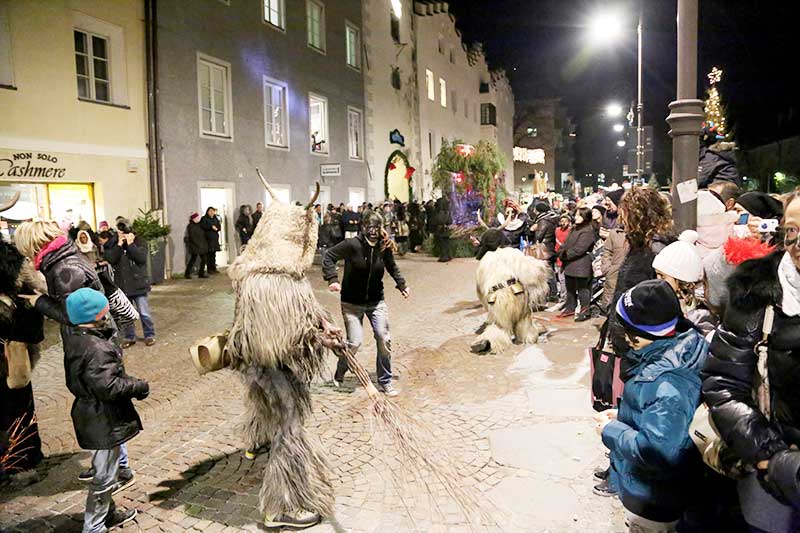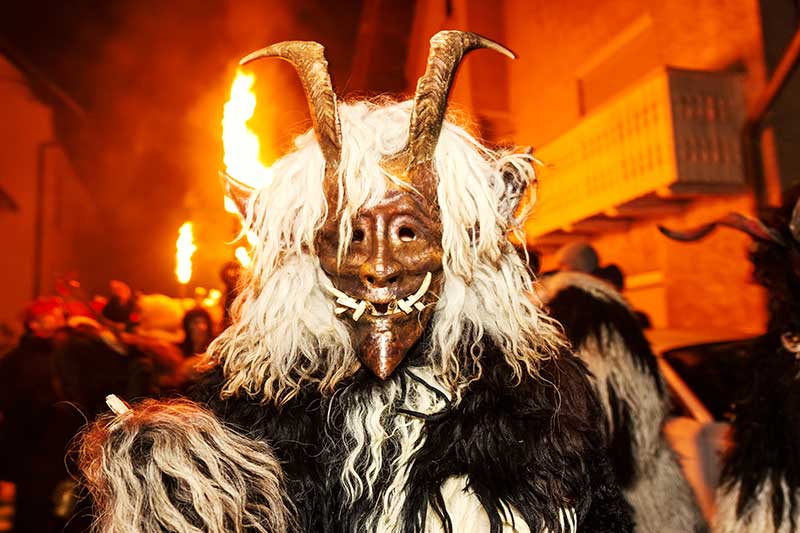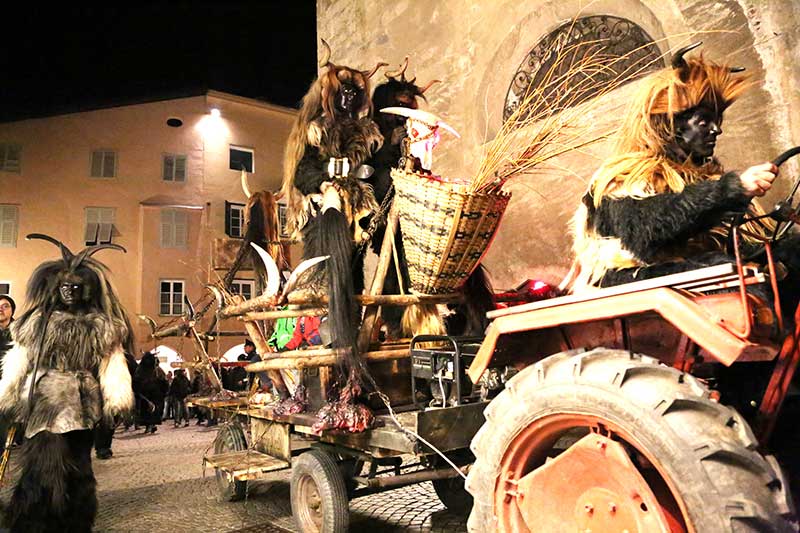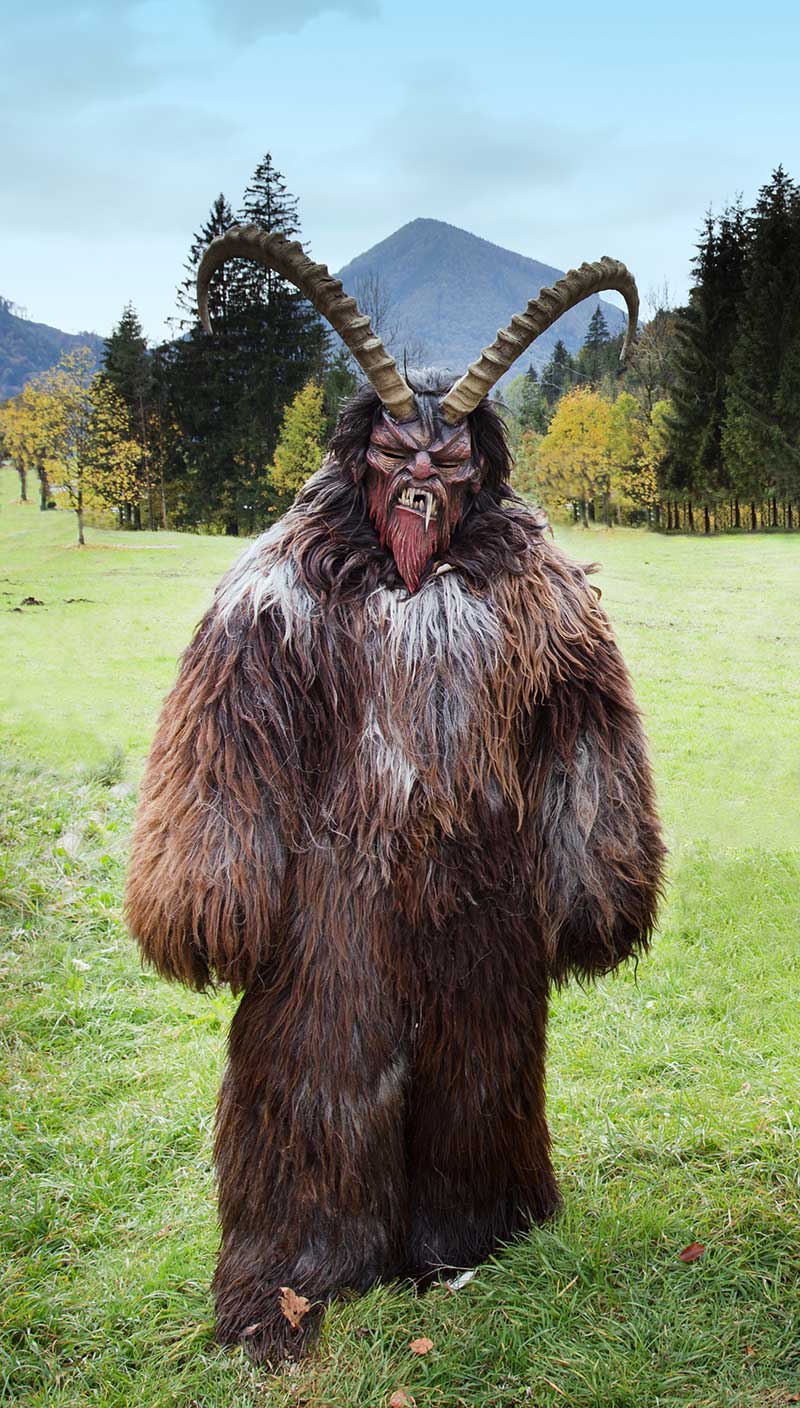Oh the delights of Christmas in an Italian village with all its endearing traditions! Twinkling lights, carols floating on air, the revered nativity crèche, spiced aromas of mulled wine tickling your nose…so much to delight the senses and wrap you up in a warm hug of Christmas happiness!
Holiday visitors to almost every town in Italy can count on sugary sweet memories being made in these winter wonderlands. But be warned! If you happen to find yourself somewhere in the northern reaches of Italy, you might be in for an unexpected fright.

© Dreamstime
Each December 6th brings the observance of St. Nicholas Day throughout Italy, with varied traditions of celebration unfolding from one end of the country to the other. Observances in German-influenced Northern provinces such as Trentino-Alto Adige and Friuli-Venezia Giulia include post-card perfect markets and almost always a lively parade featuring the jolly ol’ saint himself… and one other character that can turn those dreams of a white Christmas into a run-for-your-life nightmare.
It’s time for the traditional Krampuslauf Parade – literally the Krampus Run – and the appearance of an other-worldly figure known as the Krampus. In towns such as Castelrotto and Dobbiaco, the spectacle begins to unfold on the evening of December 5th, known as Krampusnacht – Krampus Night. As late day dissolves into twilight, devilish figures begin to appear, wandering, mingling in increasing numbers within the market and streets. Their lurking bodies are clothed in Barbarian-inspired fur garments, and for now, their human features vanish behind ghoulish fanged masks topped with spiraling horns. These Kastelruther Tuifl, human devils, seem to overtake the town, peacefully at least for the momenet, as they gather in preparation for the evening’s parade.

© Dreamstime
As night falls, the townsfolk line the streets, ready for what awaits. The glow of approaching torches rises over the crowds; menacing growls, hoots, yells, and the sounds of clanging chains and bells grow louder and louder as a legion of Krampus’ descend helter-skelter down the main thoroughfare. And surprisingly so, at least for someone new to the spectacle, a grandfatherly red and white robed St. Nicholas leads the way.
Like oil and water, the traditions of St. Nicholas and Krampus just don’t seem to mesh. So how did this menacing beast find a right-hand position alongside the kind, benevolent saint? No one knows for certain the origins of the Krampus, but most probably he was a central figure in pre-Christian era pagan dramas centered around the dark spirits of winter. Along the way, his persona was adopted into the storyline of St. Nicholas, perhaps fulfilling the role of the malevolent balancing the benevolent.

© Dreamstime
Krampus’ more recent job description casts him as the antagonist in the good-versus-bad child’s saga of the season. While St. Nicholas bestows gifts upon the wee ones who’ve behaved well enough during the year, Krampus picks up the slack for the not so well-behaved. Lumps of coal for gifts, lashes with birch straps, even kidnapping with threats of never being seen again loom as motivators to stay on the good list. Even with the harrowing appearance of all those who slip into the role of Krampus, festivities remain lighthearted; most children today delight in the temporary frights of the Christmastime beast.
Despite the persona of Krampus having ancient roots, Krampus Runs are a fairly recent phenomenon, even if the tradition of his participation in Yuletide celebrations is long-standing. And tradition is key to the continuation of these celebrations. Die Kastelruther Tuifl, an association formed in 2011, plays a big part in supporting Krampuslauf events. Membership is small but growing, and an 18-and-under branch was recently formed to support and encourage the interest of youth. As Markus Rauch, an association member, explains, “…this is our final goal – passing tradition on to the new generations.”

© Dreamstime
Integral to preserving the tradition are the costumes; each Krampus outfit is unique. Distinctive styles of horns, color or type of fur, even the manner of chains or sticks used to scare the crowds are individual works of creativity. Masks are intricately hand carved from wood, each a unique work of art that is considered an heirloom to be passed on to the next generation, horrifying effects and all. And as photos will attest, the scarier and more hellish, the better.
The largest Krampus Run in Italy takes place in Dobbiaco, a quaint Alpine village located in South Tyrol – Alto Adige, known as the “Gateway to the Dolomites.” Nestled in the fertile valley beneath Italy’s famous Tre Cime peaks, the tranquil serenity of this idyllic hamlet erupts into a fiery netherworld each St. Nicholas Eve. As many as 600 Krampus swarm the small town, careening and cavorting as they seemingly spill from the mountainsides to mischievously menace and intimidate. A number of the participating Krampus characters come from neighboring Switzerland, Austria, and even Slovenia, as well as other areas of northern Italy. Collective groups often include a uniqueness to their costumes that identifies their origin such as a particular style of horns or fur combinations. These days, every Krampus is also required to be registered and wear a number. Word has it that parades in days past got a little too devilish — this method provides healthy accountability!

© Dreamstime
Most towns that host a Krampus Run find ways to continue the merriment after the parade. Warm tents serve as nests of ongoing Krampus mischief while townsfolks dance the dark winter spirits away. Frightful, possibly even a bit unsettling, the beastly demons live on as a beloved tradition in these parts. Just be sure you find yourself on St. Nicholas’ good list…or else!
Oh le delizie del Natale in un villaggio italiano con tutte le sue tradizioni accattivanti! Luci scintillanti, canti che fluttuano nell’aria, il venerato presepe, aromi speziati di vin brulé che solleticano il naso…..tanto per deliziare i sensi e avvolgervi in un caldo abbraccio di felicità natalizia!
I visitatori in vacanza in quasi tutte le città d’Italia possono contare su dolci ricordi di queste meraviglie invernali. Ma attenzione! Se vi capita di trovarvi da qualche parte nel Nord Italia, potreste inaspettatamente spaventarvi.
Ogni 6 dicembre porta l’osservanza del giorno di San Nicola in tutta Italia, con varie tradizioni di celebrazione che si svolgono da un capo all’altro del paese.
Le celebrazioni nelle province settentrionali di influenza tedesca come il Trentino-Alto Adige e il Friuli-Venezia Giulia comprendono impeccabili mercatini e quasi sempre una vivace sfilata con lo stesso allegro vecchio santo….. e un altro personaggio che può trasformare i sogni di un bianco Natale in un incubo per tutta la vita.
E’ tempo per la tradizionale corsa del Krampuslauf e l’apparizione di una figura conosciuta come il Krampus. In città come Castelrotto e Dobbiaco, lo spettacolo inizia la sera del 5 dicembre, conosciuta come Krampusnacht – note del Krampus. Quando la tarda giornata si dissolve nel crepuscolo, cominciano ad apparire figure diaboliche, che vagano e si, mescolano in numero crescente all’interno del mercato e per le strade. I loro corpi in agguato sono vestiti di pellicce di ispirazione barbarica e i loro tratti umani svaniscono dietro maschere macabre sormontate da corna a spirale. Questi Kastelruther Tuifl, i diavoli umani, sembrano occupare le città, pacificamente, almeno per il momento, mentre si riuniscono in preparazione della sfilata serale.
Al calare della notte, i cittadini fiancheggiano le strade, pronti per ciò che li attende. Il bagliore delle torce che si avvicinano si innalza sopra la folla; crescono sempre più forti i rintocchi, le urla e i suoni delle catene e delle campane che tintinnano, mentre una legione di Krampus scende confusamente lungo la via principale. E sorprendentemente, almeno per chi è nuovo a questo spettacolo, ad aprire la strada c’è un vecchio San Nicola vestito di rosso e bianco.
Come l’olio e l’acqua, le tradizioni di San Nicola e dei Krampus non sembrano essere in sintonia. Come ha fatto questa bestia minacciosa a trovare posto accanto al santo gentile e benevolo? Nessuno sa con certezza le origini del Krampus, ma molto probabilmente era una figura centrale nei drammi pagani di epoca precristiana, incentrati sugli spiriti oscuri dell’inverno. Lungo la strada, il suo personaggio è stato adottato nel racconto di San Nicola, svolgendo forse il ruolo del male che equilibra il bene.
La più recente descrizione del ruolo del Krampus lo proietta come l’antagonista nella saga per bambini del bene contro il male. Mentre San Nicola fa doni ai piccoli che si sono comportati abbastanza bene durante l’anno, il Krampus tiene d’occhio chi si è comportato male. Pezzi di carbone in dono, fruste con rami di betulla, persino rapimenti con la minaccia di non essere mai più visti sono le motivazioni per rimanere nella lista dei buoni. Anche con l’aspetto straziante di tutti coloro che scivolano nel ruolo di Krampus, i festeggiamenti rimangono spensierati; la maggior parte dei bambini oggi si dilettano nelle paure temporanee della bestia di Natale.
Nonostante il personaggio di Krampus abbia radici antiche, le sfilate dei Krampus sono un fenomeno abbastanza recente, anche se la tradizione della sua partecipazione alle celebrazioni dello Yuletide è di lunga data.
E la tradizione è la chiave per il proseguo di queste celebrazioni. L’associazione Die Kastelruther Tuifl, costituita nel 2011, svolge un ruolo importante nel sostenere gli eventi di Krampuslauf. Il numero di soci è piccolo ma in crescita, e recentemente è stato costituito un ramo under 18 per sostenere e incoraggiare l’interesse dei giovani. Come spiega Markus Rauch, membro dell’associazione, “….questo è il nostro obiettivo finale: trasmettere la tradizione alle nuove generazioni”.
I costumi sono parte integrante del mantenimento della tradizione; ogni abito Krampus è unico nel suo genere. Stili distintivi di corna, colore o tipo di pelliccia, anche il tipo di catene o bastoni usati per spaventare la folla sono opere individuali di creatività. Le maschere sono intricatamente intagliate a mano dal legno, ognuna è un’opera d’arte unica che è considerata un cimelio da trasmettere alla generazione successiva, con effetti orribili e tutto il resto. E come testimoniano le foto, più è spaventoso e più è infernale, e meglio è.
La più grande Krampus Run in Italia si svolge a Dobbiaco, un pittoresco villaggio alpino situato in Alto Adige, conosciuto come la “Porta delle Dolomiti”. Immerso nella fertile valle sotto le famose Tre Cime italiane, la tranquilla serenità di questo idilliaco borgo esplode in un mondo sotterraneo infuocato ogni notte di San Nicola. Ben 600 Krampus sciamano nel piccolo paese, correndo e infilandosi ovunque come se si rovesciassero dai fianchi delle montagne per minacciare e intimidire sornioni. Alcuni dei Krampus partecipanti provengono dalla vicina Svizzera, dall’Austria e persino dalla Slovenia, così come da altre zone del nord Italia. I gruppi collettivi spesso includono un’unicità dei loro costumi che ne identifica l’origine, come ad esempio uno stile particolare di corna o combinazioni di pellicce. In questi giorni, ogni Krampus deve essere registrato e indossare un numero. Si dice che le sfilate dei giorni passati erano diventate un po’ troppo diaboliche: questo metodo fornisce una sana responsabilità!
La maggior parte delle città che ospitano una sfilata dei Krampus trovano il modo di continuare l’allegria dopo la sfilata. Le tende calde fungono da punti di ritrovo per i Krampus in corsa, mentre i cittadini danzano per cacciare i bui spiriti invernali. Spaventosi, forse anche un po’ inquietanti, i demoni bestiali vivono come una tradizione amata da queste parti.
Assicuratevi di trovarvi sulla lista buona di San Nicola….altrimenti…!



































